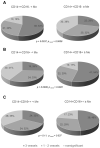The Association of Lipoprotein(a) and Circulating Monocyte Subsets with Severe Coronary Atherosclerosis
- PMID: 34206012
- PMCID: PMC8228191
- DOI: 10.3390/jcdd8060063
The Association of Lipoprotein(a) and Circulating Monocyte Subsets with Severe Coronary Atherosclerosis
Abstract
Background and aims: Chronic inflammation associated with the uncontrolled activation of innate and acquired immunity plays a fundamental role in all stages of atherogenesis. Monocytes are a heterogeneous population and each subset contributes differently to the inflammatory process. A high level of lipoprotein(a) (Lp(a)) is a proven cardiovascular risk factor. The aim of the study was to investigate the association between the increased concentration of Lp(a) and monocyte subpopulations in patients with a different severity of coronary atherosclerosis.
Methods: 150 patients (124 males) with a median age of 60 years undergoing a coronary angiography were enrolled. Lipids, Lp(a), autoantibodies, blood cell counts and monocyte subpopulations (classical, intermediate, non-classical) were analyzed.
Results: The patients were divided into two groups depending on the Lp(a) concentration: normal Lp(a) < 30 mg/dL (n = 82) and hyperLp(a) ≥ 30 mg/dL (n = 68). Patients of both groups were comparable by risk factors, autoantibody levels and blood cell counts. In patients with hyperlipoproteinemia(a) the content (absolute and relative) of non-classical monocytes was higher (71.0 (56.6; 105.7) vs. 62.2 (45.7; 82.4) 103/mL and 17.7 (13.0; 23.3) vs. 15.1 (11.4; 19.4) %, respectively, p < 0.05). The association of the relative content of non-classical monocytes with the Lp(a) concentration retained a statistical significance when adjusted for gender and age (r = 0.18, p = 0.03). The severity of coronary atherosclerosis was associated with the Lp(a) concentration as well as the relative and absolute (p < 0.05) content of classical monocytes. The high content of non-classical monocytes (OR = 3.5, 95% CI 1.2-10.8) as well as intermediate monocytes (OR = 8.7, 2.5-30.6) in patients with hyperlipoproteinemia(a) were associated with triple-vessel coronary disease compared with patients with a normal Lp(a) level and a low content of monocytes.
Conclusion: Hyperlipoproteinemia(a) and a decreased quantity of classical monocytes were associated with the severity of coronary atherosclerosis. The expansion of CD16+ monocytes (intermediate and non-classical) in the presence of hyperlipoproteinemia(a) significantly increased the risk of triple-vessel coronary disease.
Keywords: atherosclerosis; autoantibodies; coronary artery disease; hyperlipoproteinemia(a); inflammation; intermediate CD14++CD16+ monocyte; lipoprotein(a); monocyte subset; multivessel coronary disease; non-classical CD14+CD16++ monocyte.
Conflict of interest statement
The authors declare no conflict of interest.
Figures




References
-
- Tsimikas S., Fazio S., Ferdinand K.C., Ginsberg H.N., Koschinsky M.L., Marcovina S.M., Moriarty P.M., Rader D.J., Remaley A.T., Reyes-Soffer G., et al. NHLBI Working Group Recommendations to Reduce Lipoprotein(a)-Mediated Risk of Cardiovascular Disease and Aortic Stenosis. J. Am. Coll. Cardiol. 2018;71:177–192. doi: 10.1016/j.jacc.2017.11.014. - DOI - PMC - PubMed
-
- Afanasieva O.I., Pokrovsky S.N. Hyperlipoproteidemia(a) as a dangerous genetically determined disorder of lipid metabolism and risk factors for atherothrombosis and cardiovascular disease. Russ. J. Cardiol. 2019;24:101–108. doi: 10.15829/1560-4071-2019-5-101-108. - DOI
-
- Capoulade R., Yeang C., Chan K.L., Pibarot P., Tsimikas S. Association of Mild to Moderate Aortic Valve Stenosis Progression With Higher Lipoprotein(a) and Oxidized Phospholipid Levels: Secondary Analysis of a Randomized Clinical Trial. JAMA Cardiol. 2018;3:1212–1217. doi: 10.1001/jamacardio.2018.3798. - DOI - PMC - PubMed
LinkOut - more resources
Full Text Sources
Research Materials
Miscellaneous

